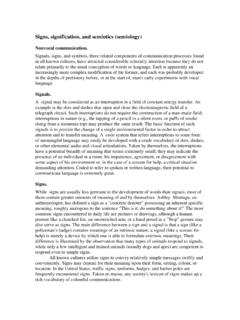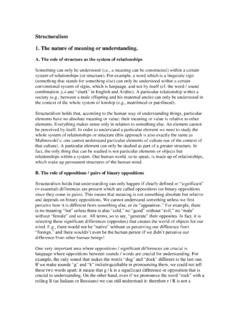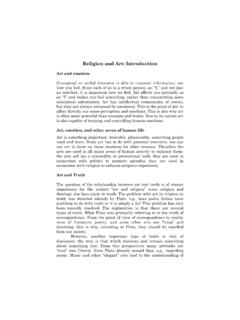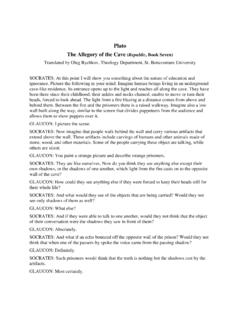Transcription of Modern Physics Notes - St. Bonaventure University
1 Modern Physics Notes J Kiefer 2006. Table of Contents TABLE OF 1. I. RELATIVITY .. 2. A. Frames of 2. B. Special Relativity .. 5. C. Consequences of the Principle of Special Relativity .. 8. D. Energy and Momentum .. 14. E. A Hint of General 19. II. QUANTUM THEORY .. 21. A. Black Body 21. B. Photons .. 27. C. Matter 30. D. 37. III. QUANTUM MECHANICS & ATOMIC STRUCTURE (ABBREVIATED) .. 45. A. Schr dinger Wave Equation One Dimensional .. 45. B. One-Dimensional 47. D. The Hydrogen 52. E. Multi-electron Atoms.
2 59. 1. I. Relativity A. Frames of Reference Physical systems are always observed from some point of view. That is, the displacement, velocity, and acceleration of a particle are measured relative to some selected origin and coordinate axes. If a different origin and/or set of axes is used, then different numerical values . are obtained for r , v , and a , even though the physical event is the same. An event is a physical phenomenon which occurs at a specified point in space and time. 1. Inertial Frames of Reference a.
3 Definition An inertial frame is one in which Newton's Laws of Motion are valid. Moreover, any frame moving with constant velocity with respect to an inertial frame is also an inertial frame of . reference. While r and v would have different numerical values as measured in the two . frames, F = ma in both frames. b. Newtonian relativity Quote: The Laws of Mechanics are the same in all inertial reference frames. What does the same mean? It means that the equations and formulae have identical forms, while the numerical values of the variables may differ between two inertial frames.
4 C. Fundamental frame It follows that there is no preferred frame of reference none is more fundamental than another. 2. Transformations Between Inertial Frames a. Two inertial frames Consider two reference frames one attached to a cart which rolls along the ground. Observers on the ground and on the cart observe the motion of an object of mass m.. The S'-frame is moving with velocity v relative to the S-frame. As observed in the two frames: 2. x . In S' we'd measure t', x', and u x = . t . x In S we'd measure t, x, and u x =.
5 T b. Galilean transformation Implicitly, we assume that t = t . Also, we assume that the origins coincide at t = 0. Then x = x + v x t . y = y + v y t . z = z + v z t . t = t . The corresponding velocity transformations are dx dx . ux = = + vx = u x + vx dt dt dy dy . uy = = + vy = uy + vy dt dt dz dz . uz = = + vz = u z + vz dt dt For acceleration du dv ax = x = ax + x dt dt du y dv = a y +. y ay =. dt dt du dv az = z = az + z dt dt . Note that for two inertial frames, the a x = a x , a y = a y , and a z = a z.
6 3. Example S-frame / / /. / du dp F = ma = m = , if m is constant. dt dt S'-frame / / / / / /. / dp / / / / / du dv du /. F = ma = , where p = mu . But u = u v , so F = m =m = F . That is, dt dt dt dt / /. a = a , as they must for 2 inertial reference frames. Notice the technique. Write the 2nd Law in the S'-frame, then transform the position and velocity vectors to the S-frame. 4. B. Special Relativity 1. Michelson-Morley a. Wave speeds Midway through the 19th century, it was established that light is an electromagnetic (E-M) wave.
7 Maxwell showed that these waves propagate through the vacuum with a speed c 3 x10 8 m/sec. Now, wave motion was well understood, so it was expected that light waves would behave exactly as sound waves do. Particularly the measured wave speed was expected to depend on the frame of reference.. In the S-frame, the speed of sound is u ; in the S'-frame the speed is u . The source and the / / /. medium are at rest in the S-frame. We find (measure) that u = u + v , in conformity with Newtonian or Galilean relativity.
8 We may identify a preferred reference frame, the frame in which the medium is at rest. b. Michelson-Morley Throughout the latter portion of the 19th century, experiments were performed to identify that preferred reference frame for light waves. The questions were, what is the medium in which light waves travel and in what reference frame is that medium at rest? That hypothetical medium was given the name luminiferous ether ( ther). As a medium for wave propagation, the ether must be very stiff, yet offer no apparent resistance to motion of material objects through it.
9 The classic experiment to detect the ether is the Michelson-Morley experiment. It uses interference to show a phase shift between light waves propagating the same distance but in different directions. The whole apparatus (and the Earth) is presumed to be traveling through the . ether with velocity, v . A light beam from the source is split into two beams which reflect from the mirrors and are recombined at the beam splitter . forming an interference pattern which is projected on the screen. Take a look at 5.
10 The two light rays as observed in the ether rest frame. The sideward ray: The time required for the light ray to travel from the splitter to the mirror is obtained from 1. v2 2. (ct ) = + (vt ) t = 1 2 . 2 2 2.. c c . Now c >> v, so use the binomial theorem to simplify 1 v2 . n(n + 1) 2 t 1 + . (1 x) n = 1 + nx + x + c 2 c 2 . 2! 2 1 v 2 . The total time to return to the splitter is twice this: t1 = 2t 1 + . c 2 c 2 . For the forward light ray, the elapsed time from splitter to mirror to splitter is 2 v 2 2 v 2.








